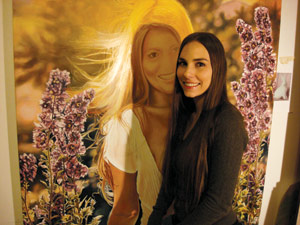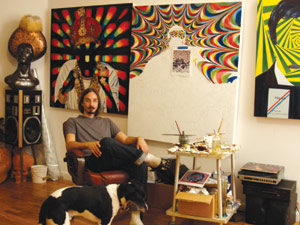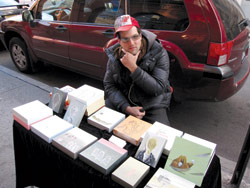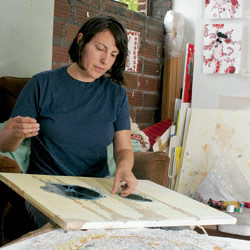When Ryan Ford arrived in New York City nearly four years ago, he carried only a backpack of clothes and $300 in his pocket. Ford, a painter who has shown his work widely in the WNC area, had decided to move to the Big Apple in an effort to take his art more seriously.

"After being in Asheville for four years, I felt ready to make something happen. I had poured my heart out in Asheville throwing awesome shows with a crew of mad-talented artists of all sorts, and there was very little return — almost no return, financially," he says. "That's the number one reason" why he left, he Ford adds.
It's a story we're all familiar with: Small-town artist breaks out and heads into the big city to find fame and fortune. Indeed, this is the legend that has propelled such greats as Bob Dylan, Jackson Pollack and Andy Warhol.
On a recent visit to New York City, Xpress caught up with Ford and former Asheville artists Lauren Gibbes and Jason Weatherspoon, who'd made the big move some years ago, to report their thoughts on life as an artist in NYC versus small-town Asheville.
"When I lived in Asheville, my artistic sight could span a distance of 90 degrees," says Ford. "Since I've lived in New York City, my sight spans 360 degrees." It's easy to comprehend a remark like this when you consider that NYC boasts more than 80 major museums, nearly 1,000 galleries (though that number fluctuates daily), 34 colleges, hundreds of theaters, historic architecture, monumental parks and a 24-hour mass-transit system that acts as the arteries of this city that never sleeps.
Add to this a multicultural population of 8.3 million people, where more than 170 different languages are spoken, and a richly documented history of creative movements such as Tin Pan Alley, the Harlem Renaissance, abstract expressionism, hip-hop, salsa and disco. Outgrowths in movements like punk rock and beat poetry also were spurred by the influx of bohemians and artists during the '50s and '60s.
Rock icon and poetess Patti Smith put it best in her "A Little Prayer for New York": "New York is the thing that formed me. New York is the thing that deformed me. New York is the thing that perverted me. New York is the thing that converted me."

But those cultural movements and the artists associated with them were spawned in an era when rents and the cost of living in New York were considerably cheaper than they are now. These days, many artists question the advantage of living in a city with high rents and dense population — not to mention the grit and grime of city living.
"It takes a really long time to come around to liking the city," Ford says. "But I love this place now. It makes you tough as nails. People always test you here: It forces you to be social and upfront like no other place, and for a creative person that's always stuck in their shell, this can be a positive experience. I still feel like I'm growing here as a stronger person for myself and my artwork."
Today Ford lives in Bushwick, Brooklyn, a place he refers to as "hell on earth." He explains: "The air stinks from food-distribution plants, stinky recycle places and just pollution in general. [There are] fast cars everywhere, confrontational people, loud ambulances and car systems. I wake up and walk down a hallway that stinks like dead people because so many rats die down in the basement."
For $430 a month, Ford rents an apartment with two other people. He paints out of a spacious studio that he shares with four artists, paying $315 a month for the space. Located in a renovated warehouse just blocks from his apartment, the 1,200-square-foot studio has wood floors, skylights and 15-foot ceilings.

Since his move in 2006, Ford has exhibited his paintings in a handful of group shows around the city and has started a T-shirt business featuring his silkscreen designs. Mostly he concerns himself with developing his art — large imaginative and detailed narrative oil paintings, often affixed with sculptural elements giving them a three-dimensional form.
Recently Ford began selling small paintings of inventive characters often posed in inspired scenarios, on the streets of Brooklyn and Manhattan under the alias "Rotgut." "I can make anywhere between $70 and $200 dollars a day, and it's a lot of fun talking to people" he says.
"New York is kinda like a big Ferris wheel, and you're always trying to hold on, and its always trying to kick you off," says Ford. "Lets put it this way: The contemporary-art world doesn't need you. It's already flooded with so many people." Later, he confesses, "But the fast-paced vibe of the city sucks you in. You become addicted to it like a drug."
On occasion, Ford still visits Asheville, and he admits to missing the community feeling that Asheville offers. "People don't have time in New York. You fight for every moment. You value your time here [in NYC] more."
Missing freedom, finding opportunity
Jason Weatherspoon and his wife, Lauren Gibbes, both artists who moved to New York City more than two years ago, agree. "What I miss most about Asheville is freedom," Weatherspoon says, laughing. "We really owned our time there."
"I miss having a car," Gibbes says. "Things are so spread out here, and it takes an hour to get anywhere. It just requires more effort and more organization — like only buying enough groceries that you can carry. Getting art supplies is more difficult because you can't just return to the store if you forgot something."
While living in Asheville, the couple resided and worked out of a studio they had renovated in the Wedge Building and were known around town for curating shows at John Payne's Gallery in the same building. "You have to create your own scene in Asheville," Gibbes says. "Here you just plug in. There's always something going on; no matter what you're doing, there's something else to do."
The two arrived in New York with a 26-foot U-Haul truck in July 2007 and promptly moved into an apartment in Bushwick they found on craigslist. (Coincidentally, the apartment was located in the same building that Ford was living in a the time.)
Says Weatherspoon: "I knew what was going to happen if I stayed in Asheville: house, baby, career — a good life. I had a great network in Asheville. New York was a mystery where anything could happen."
"It was just something I always wanted to do," says Gibbes. "I wanted to be near all of the amazing museums and immerse myself in all that the city had to offer."
"For the first year and a half, we were going out all the time," says Weatherspoon. "It was a nonstop party." At that point, Gibbes had already exhibited work at some galleries, including The Cynthia Broan Gallery in Chelsea and 31 Grand in Brooklyn. (Both galleries are no longer in business.)
The couple spent their early months in the city forming networks within the creative community. "We were learning diplomacy about galleries and who to go with," says Weatherspoon, "It's like being in a cafeteria — who you sit with determines the rest of the year."
"Things really changed last winter," says Gibbes. "Galleries have dropped like flies. Up until then we were getting into group shows, and then our main gallery closed. We both had a studio visit lined up with a gallery and a week later they closed down." Weatherspoon adds, "On top of that, there are so many artists here right now who don't have a market."
Ironically, the couple says they feel lucky for their emerging position in New York's art world. " A lot of our friends had the cushion yanked out from under them – their prices were inflated to such a degree that it scared off their investors," says Weatherspoon.
The economic downturn has had some advantages, though. Faced with job losses, many professionals decided to quit the city life and sell or rent their upscale living spaces at relatively affordable prices. Taking advantage of this, Gibbes and Weatherspoon managed to secure an apartment in a swank neighborhood just two blocks from Central Park.
"Living in the Upper West Side is a nice mix of culture, nature and convenience," says Gibbes. "Right now I am really enjoying walking across Central Park to the Met [Metropolitan Museum of Art]. I feel like I'm learning so much from studying the paintings there."
And it shows. The fine-tuned hyperrealist paintings that Gibbes makes reflect an overly glamorous and commercialized way of life and have become even more refined, sleeker and more … New York City. The biggest challenge Gibbes has faced regarding her artwork is finding good-quality wood to paint upon, like she did in Asheville, so she has started paint on canvas instead.
"The difference in New York as opposed to Asheville is that here, people don't make work with the intent of selling it. It's more academic-driven — the communication of concept overshadows the drive to sell," says Weatherspoon. "In Asheville, we had so many craft contemporaries who were concerned with making their living from their art. In New York, people care more about securing gallery representation, or museum shows, or grants, or a good review. … It's not so much about the money you can make from selling the work."
Weatherspoon no longer creates the figures and sculpture that earned him a reputation in Asheville. Faced with limited resources to purchase clay or use a kiln, Weatherspoon has moved into painting. "In Asheville everyone has a kiln and a loading dock — getting clay was easy. When I moved to New York I was creatively stifled because I couldn't find the proper facilities in Bushwick to work out of."
Referencing the patterns and geometric shapes that once graced his ceramic sculptures, Weatherspoon began juxtaposing them with realistically rendered images for an overall effect that reads like an optical illusion of shifting perspectives. "New York City charged my art," he says. "In Asheville it was more nature-based. Here I'm so over-stimulated — this is more of my reality."
The reality is that the couple is paying more each year in rent than Weatherspoon made from a year's work in Asheville. To pay the bills, Gibbes works part time writing subtitles (a job she had while she lived in Asheville), and Weatherspoon works with museums and galleries as an art handler, hanging the works of big-name artists like Mathew Barney for big-time curators like Nancy Spector in venues like the Guggenheim Museum. "It's a perfect job for artists because you get to be around so much art," he says. "My construction background and those years I spent helping Lauren curate shows in Asheville have come full circle."
Currently Gibbes and Weatherspoon are collaborating on a children's book, and just last month, Gibbes acquired representation by Betsy Bickar of the recently formed Galeria Bickar out of San Jose, Costa Rica. She was also included in a group show at Camel Art Space in Brooklyn, which received a mention in New York Magazine. Camel Art Space is an artist-run gallery much like the Flood Gallery in Asheville.
"There have been quite a few artist spaces popping up in NYC since the recession hit, which is really exciting," says Gibbes. The art scene "is going back to be more of a grassroots thing, with more people curating out of their apartments. It's more intimate now."
New York City "is an expensive place to live but there is tons of opportunity so it sort of equals out" says Gibbes. Weatherspoon adds, "If I were to sum up what keeps us here in a word it would be 'energy.' You can feel it as you drive over the bridge or emerge from the tunnel. This place is like fission."
Ryan Ford shares that sentiment. "You will never see me moving to a small town again," he says. "But I will always love Asheville, and I still love some of the Asheville artists more than any other artists I've seen in New York so far."




I want my 5 minutes back, please
If this was the utopiah of Artists then why didnt they stay . . Thats right the Art scene around here doesnt produce NY Standards, or allow you to live off of
You should buy a clock then, or say something more useful.
You should buy a clock then, or say something more useful.
This article raises some good questions about whether artists can earn a living and gain recognition while living in Asheville. Of course, the same could be asked about artists living in New York. Which would a talented Asheville artist prefer, to be considered one of the very best, most successful artists in Asheville, or to be one of the many, many talented artists struggling to become known in New York?
Ah, Asheville Dweller… If you couldn’t wake up each day with fresh hate in your heart, you wouldn’t be able to go on living, would you?
I don’t hate, I just see things for what they are, unlike you that see’s what ever is spoon fed to them afraid to step out of status quo thought, its ok you wil grow up soon enough.
It’s amusing how you tell me I’m the one who will grow up soon enough, Asheville Dweller, when I’m not the one who is shocked — shocked, I tell you! — and appalled on a daily basis by simple human nature and the fact that people in Asheville act like people.
Shall we sum it up and save you time? Here, cut and paste this in every thread from now on and consider it my Christmas gift to you:
[b]Asheville is the most terrible, horrible, no-good, very bad place in the whole wide world.[/b]
There you go. Now you won’t have to spend all that time typing up individual complaints every day.
Awwww lookd like Hauntedhead Doesnt like opinions that differs from his . . . Good ol lockstep Asheville, “Different Opinions rock if you share the same opinion” How Boring progressives are.
Wherever You Go
That’s Where You Are
great article. i really like mr weathersponn’s comment; “What I miss most about Asheville is freedom. We really owned our time there.”
i think that describes many people’s experience in asheville, especially in the late 90’s/early oughts.
Well written, well done.
also, what exactly is ‘Mysterylogger’s” point and how does it further anything resembling intelligent discourse?
He/she’s just airing vague, petty gripes about ‘asheville progressives’ in any thread he can even remotely connect to his pet peeve. it takes away from any potentially constructive dialogue in these threads to have to wade through that kind of ‘everything here sucks’ crap.
I was wondering how it was going for the two of them in New York. I am not sure if paying probably $1000.00 or more a month in rent for a New York loft helps a struggling artist ‘make it’ in the art scene though.
I do not think moving off to a big city is a sure fire way to become a well-known artist. If you are truly talented your efforts will be apparent where ever you are and patience will pay off. If they make it, I applaud them, only time will tell.
Its just like the Hypocrisy of this town thats great, be a free thinker and think outside the box but dont setp outside status quo.
So much for being an open minded thinker aka Progressive.
Get over yourself Arguer all you do is whine and moan when some one says something about this town you dissagree with, might want to get a back bone and grow up some.
Jane-
“I am not sure if paying probably $1000.00 or more a month in rent for a New York loft helps a struggling artist ‘make it’ in the art scene though.
I do not think moving off to a big city is a sure fire way to become a well-known artist.”
That’s a pretty dumb statement. I didn’t see where anybody said anything was sure fire. It takes a lot of guts to move off to one of the hardest most expensive cities in the world. I applaud them for not taking the safe easy route. They seem to be enjoying life, and as far as I am concerned that is “making it”.
May I suggest Richmond somewhere close to the Virginia Museum of Fine Art. There’s good energy, the museum is superb and the curator of 21st century art has the best eye I’ve seen in years.
The strength of Jason Weatherspoon is sculpture but he needs to go to bronze and for that effort he needs to move to Santa Fe. New York has become image conscious living in reveries of past glories. This article reflects a provincial mind set, be it New York or Asheville.
Santa Fe is happening, now.
Richmond is happening now. The VMFA, with its new addition, is superb. If I were a visual artist and wished for inspiration, reduced living expenses and wished to stay on the East Coast, I’d move to Richmond. Richmond is not Artsy F*rsty and the museum is not pretentious but the collection of art is quite good. They do not hang less than good work by named artist. Their Keifer is a good Keifer and the current Chuck Close show, while small, is chocked full of important pieces offering good perspective on the compositional detail of Close. The VMFA is bar far the best art museum in the South. Oh yes, the Dega room of sculpture and painting rocks. Go to Richmond Jason and take a trip to Santa Fe now and then and check out Shidoni Foundry.
You’re very good. Go for it. You will not find the energy you need in NC.